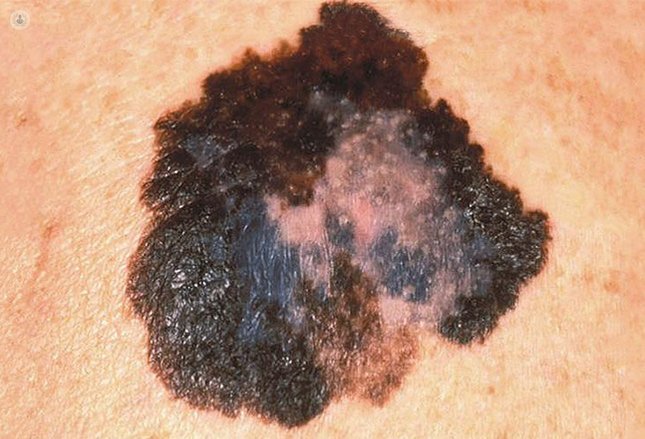The signs and treatments of melanoma
Written by:What is melanoma?
Malignant melanoma is a type of skin cancer that develops in the cells that contain pigment, known as melanocytes. Melanoma is the most dangerous type of skin cancer with a mortality rate of around 20% in those where the cancer has been undetected and has spread.

How do you detect melanoma?
Early detection is important as the chances of spreading beyond the skin are increased if surgical removal is delayed. Survival of the patient is determined by the thickness of the lesion when removed.
Melanoma can arise within a pre-existing mole or on normal skin. Any pigmented lesion that changes, enlarges, becomes irregular in shape or bleeds should be checked.
What are the causes of melanoma?
Most skin cancers result from chronic or continued sun exposure and are therefore more common in older people.
Melanomas often arise in sun-exposed areas of the body, but intermittent exposure to high levels of ultra-violet light, for example annual holidays in the sun, can play a critical role in producing melanomas.
Melanoma affects a younger age group than non-melanoma skin cancers. It is more common in people with fair skin, those with a history of sunburn in childhood, individuals with numerous moles, and people who have used sun-beds.
Is melanoma genetic?
About 5% of melanomas are genetically determined. Anyone with a family history of melanoma should be checked by a dermatologist, particularly if they have numerous moles or if more than one close relative is affected.
Should people have regular skin check-ups?
Depending on a person’s past history of sun exposure, their skin type, and the number of moles they exhibit. If they have had a melanoma removed previously they require regular follow-ups, as do patients with numerous moles, particularly if they are irregular or abnormal.

A dermatologist can tell a lot about moles by examining them with a dermatoscope, which can help determine the need for regular follow-up or biopsy. In addition patients with numerous moles can be mole-mapped so that there is a base-line photographic record. This can be very valuable in determining whether an existing mole has changed, or a new mole has appeared.
What are the available treatments for melanoma? The most important procedure is prompt excision of a suspicious lesion. If a melanoma is diagnosed by the pathologist, then a wider excision is indicated. In addition patients with an invasive melanoma that is more than 1mm thick, can be offered a sentinel lymph node biopsy (SLNB) which is performed at the same time as the wider excision.
This procedure involves the identification and removal of the lymph node or nodes that drain the area of skin on which the melanoma has arisen. Examination of the nodes microscopically will help to establish whether the melanoma has spread beyond the skin.
SLNB is a staging procedure and therefore provides more accurate information on survival. It also identifies those patients that may require further treatment.
Are there any other new treatments?
There has been significant progress in the treatment of metastatic melanoma over the past decade, and a number of new agents are now available which show considerable promise.
Currently these are reserved for patients with inoperable disease, but this is a rapidly developing field and trials of adjuvant therapy to prevent recurrence (following the surgical removal of lymph-nodes for example) are in progress.



